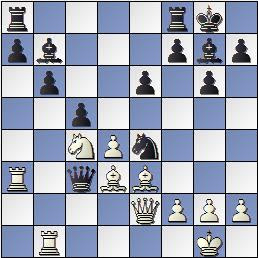I had been casting about for things to pique my interest and thought that reading a book about Paul Morphy might do the trick. I had done some translating of a German book about Leonid Kubbel and thought that translating a Spanish book about Morphy might also be entertaining. Alas, most games were listed in this book with little commentary. Eventually, I found Johann Lowenthal's book on Morphy. While dated, it provided me with a suitable biography and a selection of games against Adolf Anderssen. It was rather sad to read of his problems late in life and the fact that he never seemed to have a worthy rival to push him to greater heights. None of his games are in Burgess' World's Greatest Chess Games, not even the Opera Game, since his opposition during his brilliant games was rather weak.
With only a modicum of humility, I submit one of the games I played this year for the adjective of Morphyesque. In any event, I might as well dedicate this game to his memory. It was played at tournament time controls against an opponent with Elo 1900. It is short enough that I'm not going to use any diagrams, but instead appeal to the reader to try to follow the game "blindfolded". I have White against N.N.(1900).
1. e4 e5 2. Bc4 Nf6 3. d4 The Urusov Gambit is like the Scotch Gambit for the Bishop's Opening. It aims to open up the game quickly where tactics may provide for a quick win for White. There are a decent number of transpositions to Two Knights Defense and the Max Lange Attack. 3...Nxe4 Risky, but not bad yet. The worst part of this move is that Black begins to violate all kinds of opening principles, e.g. moving pieces multiple times and falling way behind in development. 4. dxe5 Notice that the knight is centralized but awkward because the pawn prevents the natural retreat to f6. 4...Nc5 5. Nf3 Ne6 6. O-O White hasn't even gambited a pawn and he has a strong e5 pawn, two naturally strong minor pieces, a castled king, and some possible heavy piece action on the d- and e-file. Black does not sense the danger and tries to catch up in development with an aggressive piece posting. 6...Bc5 7. Nc3 With the e5 pawn leading the charge, I have the natural Ne4 coming. My opponent saw this move and wasted two more tempi getting his bishop to a7. 7...a6? 8. Ne4 Ba7??
What move should White play? Hint: It's a developing move. If you are following along with no chess board in front of you, Black has two pieces developed: a knight at e6 and a bishop at a7. He also has moved one pawn to a6 and his e-pawn is missing. The rest of his pieces including QR, QN, QB, Q, K, and KR are on their home squares. White on the other hand has knights at e4 and f3, a bishop at c4, kingside castling, and the QR, QB, and Q on home squares.
9. Bg5! It looks like White is going to let Black exchange off a pair of pieces, but White gets the better of the deal. While Black loses a defender at e6, White gets the g5 outpost for his knight and opens a path to h5 for his queen. Development begets development. The pawn at e5 assures that f6 is only going to lose material for Black. 9...Nxg5 10. Nfxg5! O-O What's the naturally aggressive follow-up? 11. Qh5 h6 to prevent Qxh7#. I had calculated most of the outcome from here, but I must confess, that I didn't know what I would do if after my next move, Black sacrifices his queen. I thought I would just win the queen with Nxg5, but in another line without the queen sac, I saw that Nf6+ was strong. It turns out it remains strong even after the queen sac. I played a fun move here. 12. Qg6! My opponent resigned, so I didn't have to make the error of 12...Qxg5 13. Nxg5?!. I rationalize that maybe I would have found 12...Qxg5 13. Nf6+! Qxf6 14. exf6 and with two pins on the pawns in front of his king, Black is helpless to stop 15. Qxg7#.






















































